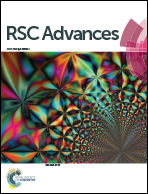All electrochemical fabrication of MoS2/graphene counter electrodes for efficient dye-sensitized solar cells†
Abstract
Exploring inexpensive, high-efficiency counter electrodes (CEs) that rival the traditional platinum (Pt) CEs for dye-sensitized solar cells (DSSCs) is a great challenge. Here we report an all electrochemical strategy to facilely prepare MoS2/graphene composite films that directly act as CEs of DSSCs without needing additional post-treatment. This strategy consists of electrodeposition and electroreduction of graphene oxide (GO) and subsequent electrodeposition of MoS2 on reduced GO layers. The as-prepared composite CEs are characterized by Raman spectroscopy, scanning electron microscopy (SEM), and transmission electron microscopy (TEM). The DSSCs based on optimized MoS2/graphene CEs exhibit a high power conversion efficiency (PCE) of 8.01%, which is comparable to 8.21% of the Pt CE. The superior PCE is indubitably attributed to the superior electrocatalytic activity of the composite CEs, as corroborated by their cyclic voltammetry (CV), Tafel polarization curves and electrochemical impedance spectra (EIS). Our all electrochemical strategy also holds promise in preparing graphene-enhanced chalcogenide functional composite films.


 Please wait while we load your content...
Please wait while we load your content...